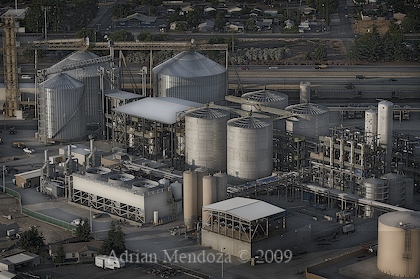The Chicago Plan Commission last week unanimously approved what would be the first sulfur processing facility in the city. But at least one commissioner had reservations, stating that he hoped he wouldn’t regret his vote since he doesn’t know what the facility could do to the environment or residents living near the Port of Chicago, where the facility is slated to be built.

“I would like to be educated on sulfur,” Commissioner George W. Migala said before voting in favor of the project. “So that in the future, if something unusual were to happen, I would not regret my vote that I may make today.”
If ultimately approved by Chicago City Council, Savage Services Co. will use the land to operate, store and ship sulfur by boat and truck to cities across the United States and internationally.
Jason Sanders, environmental director for Savage, said the liquid-based chemical would be solidified into a pellet-form byproduct– primarily used as a fertilizer–at the refinery site to make for easier storing and shipping.
He said the process of solidifying sulfur, or prilling, would not affect the environment, and said the company has applied for air and water permits from the Illinois Environmental Protection Agency.
“We will have some storm water discharge from our parking lot, so we’re working with [EPA] to get that permit as soon as possible,” said Sanders.
EPA would not confirm or deny any application from the Savage Services Co.
Jim Nelson, water specialist for the Association of Illinois Soil and Water Conservation Districts, said if the sulfur pellets were to fall from the boat or somehow get into the storm water run-off, it could cost harm.
He said often times, the water being used to cool the pellets at these types of refineries is water directly from the river, and if not treated correctly can affect the surrounding marina life.
“Keeping [sulfur] out of the water would be the key. The safety precautions on the barge, or whatever they’re using to ship this product, would be my main concern,” said Nelson, of the non-profit conservation group.
Nelson said there are two types of water pollutants, non-point and point source pollution. Non-point pollution is water run-off from agriculture, and point pollution is caused from industrial and sewage treatment plants, in this case sulfur, he said.
Savage has the nation’s largest sulfur terminals and facilities in Galveston, Texas, and Tampa, Fl.; with the capacity to receive over one million tons of liquid sulfur annually, and distribute 10 million tons.
Ed Ivey, Savage general manager, said the company’s dependency on the river was crucial in deciding the location for the plant.
He said the river would make for easy access from Lake Calumet to the Mississippi River and virtually anywhere else in the country.
“It’s definitely cheaper to ship the sulfur pellets, as opposed to trying to distribute the liquid sulfate. And the river allows us to access all Mississippi ports,” said Ivey.
Ivey said this location would bring business and jobs to the Midwest region; Ten jobs would be created at the Chicago location, including two full-time positions and up to five truck-driving jobs.
Ivey declined to say how much the facility will cost to erect.
Savage has a similar processing facility where they store and prill sulfur located in Donaldsonville, La., and serves the southern part of the United Stated.
After the meeting, one commissioner said she had received a lesson in chemistry, a subject she never particularly cared for.
“I never did well in high school chemistry, but I sure did learn a lot about sulfur today. I think [Savage] has potential,” said Commissioner Doris B. Holleb.
Peter Strazzabosco, spokesperson for zoning and land use planning, said a date for the project to be considered by the Chicago City Council to vote on the proposal hasn’t been set.







Be First to Comment